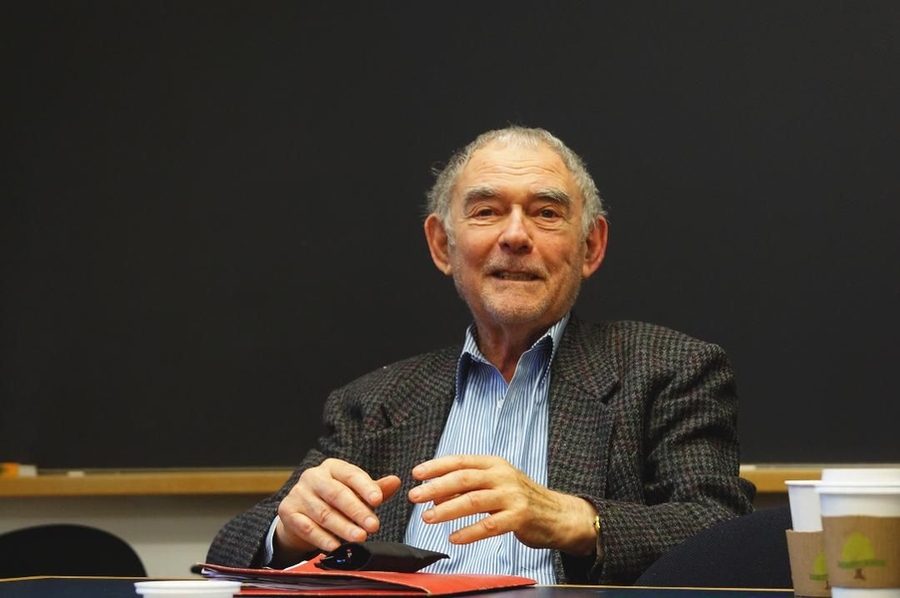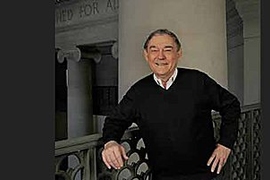Professor Emeritus Julian Beinart, an internationally celebrated architect and longtime MIT professor known for his highly influential course on urbanism, died on Oct. 2 due to complications from Parkinson’s disease. He was 88.
“Julian Beinart’s best ideals were the best ideals of this department,” says Nicholas de Monchaux, head of the MIT Department of Architecture. “A tireless student of form, he believed architecture’s role in the city also made it inextricable from politics. His legacy — in South Africa, the U.S., and beyond — also reminds us that the professional obligation of architects to the city stands alongside the civic demands on every one of us, architect or not.”
“Julian’s strengths came from an old-school faith,” says Arindam Dutta, professor of architectural history at MIT. “He believed cities were somehow designed artifacts, and in being so, they could be designed better. It was his task to train designers for this job.”
A stranger in a strange land
Born in South Africa to immigrant Jewish parents from Lithuania, Julian Beinart grew up in a small rural town about 40 miles north of Cape Town. A gifted student, he entered the University of Cape Town at age 16. In 1955 he came to MIT where he studied with György Kepes, Louis Kahn, and Kevin Lynch on his way to a master’s degree. He also earned a master’s at Yale University.
Returning to South Africa in the early 1960s, Beinart applied the skills he’d acquired at MIT to the emerging African reality. He staged a series of design workshops in five African countries, engaging the visual language of their transition from colonialism to genuine independence. He collected and wrote about African popular art and even produced recordings for South African jazz musicians. And he taught, first at Johannesburg’s Witwatersrand University, and later at the University of Cape Town, where he became dean of the faculty of architecture.
While working in the segregated Johannesburg townships that would later be known as SOWETO, Beinart marveled at the way Black African tenants tapped into a communal visual language to transform their bland government-issued apartments into rich and expressive homes. “They had something that professionals who designed housing could not access,” he would later write about the experience.
Beinart was deeply invested in the fight against apartheid, South Africa’s brutal system of racial segregation. His anti-apartheid activities soon drew government surveillance and several anonymous threats that made life uncomfortable, and even dangerous. In 1970, he and his wife emigrated to the United States, coming to MIT as heads of house at Burton House, where both their children were born and spent much of their childhood.
“I think MIT was an ideal environment for my father,” says his son, the journalist Peter Beinart. “It was cosmopolitan and represented an escape from the parochialism of apartheid South Africa. It was full of brilliant people. And it was full of immigrants, something which resonated deeply with him as the son of immigrants and an immigrant himself.”
Finding the soul of the city
In 1977, Beinart began teaching “The Theory of City Form,” a multidisciplinary course on urban history and design first launched by Kevin Lynch in the mid-1950s. He would teach that course until he retired from MIT in 2013.
“The classes were performances,” says Lawrence Vale, an alumnus of Beinart’s course and today associate dean and Ford Professor of Urban Design and Planning at MIT. “A staged dialogue between an orator and the pairs of images he scrolled through and interrogated. The classes inspired myriad topics for future theses and dissertations.”
Hundreds of MIT students took “The Theory of City Form” with Beinart. “Julian’s course enabled me to drop in anywhere in the world and get an intelligent read on a city within 24 hours of my arrival,” says course alumnus Isaac Manning SMArchS ’90, an international real estate developer who joined 50 course alumni from all parts of the world to attend Beinart’s final session in 2013. “Taking his class gave me the vocabulary for doing that, and its teachings are applicable to all the challenges we face today.”
In 1984, Beinart founded Cambridge International Design Associates. He consulted on urban plans in countries including Malaysia, Russia, and the United States. He worked closely with Teddy Kollek, the mayor of Jerusalem, on multiple projects in Israel and, following the 1993 Oslo Peace Accords, collaborated on development projects with the Palestinian Authority and with leaders in Jordan and the United Arab Emirates. From 2001 to 2005, he was in partnership with Indian architect Charles Correa MA ’55 on the design of the Brain and Cognitive Sciences Building at MIT.
He spoke with his eyes
Friends, colleagues, and family remember Beinart as an avid intellect who sought substance in nearly every conversation and exchange. “He was not afraid of silences,” recalls son Peter. “Including awkward silences. That could make a few people uncomfortable. But it also meant that if you had an interaction with him, that interaction would be meaningful.”
“He had that very rare combination of intellectual curiosity, generosity, clarity, and passion,” says Hashim Sarkis, dean of the School of Architecture and Planning.
Nader Tehrani, who headed the MIT Department of Architecture from 2010 through 2014, says Beinart treated him like a son from the moment he arrived at MIT. “When I became chair, he never patronized me. But he let me know, almost wordlessly, that he was there if I ever needed advice. Which was fortunate, because I needed a lot.”
Those closest to him describe how Beinart, while also a gifted writer, perceived and communicated most naturally on a visual level. “So much of my whole childhood was spent drawing with him, often in his MIT office,” says daughter Jeannie Beinart Stern, also a designer. “We would pass a piece of paper back and forth between us, each of us adding a line or dot or squiggle. Each seeing new possibilities in each other’s forms. More than in any other way, my father spoke with his eyes.”
Beinart believed that to really understand a city and its spaces one must experience it. “Early in his career, Julian spent several months in Assisi, studying the Italian hilltop town,” says Cara McCarty, curator emerita at Cooper Hewitt, Smithsonian Design Museum in New York, and Beinart’s longtime companion. “He hand-measured and mapped every building. He believed that measuring and drawing something were necessary steps on the way to changing it.”
A secret passion
Pensive, quiet, and sometimes withdrawn, Beinart was a passionate sports fan. He loved cricket and once traveled with son Peter to watch South Africa compete in the Bahamas. He was also a devoted fan of Boston’s Red Sox, Celtics, and Patriots. “Julian loved watching people excel,” says McCarty. “Whether intellectually, creatively, or on the playing field. He loved seeing people make the most of their abilities.”
The family has encouraged donations to the student research fund established in his memory.
Beinart's friends and family will celebrate his life and career on Sunday, Nov. 8, at 1 p.m. EST. This open virtual event will feature remarks from MIT friends, colleagues, and former students across multiple generations.







